In this article, we will look at mountains in the Bible. We will examine some popular mountains mentioned throughout scripture and their symbolic meaning.
Mountains have always held a special place in the Bible, from Mount Sinai, where Moses received the Ten Commandments, to Mount Zion, the ancient site of the Temple in Jerusalem.
Mountains are often associated with important events and encounters with God. And we will explore the significance of mountains in the Bible and what they can teach us about our faith.
One of the most famous mountain stories in the Bible is the story of Noah’s Ark. According to the book of Genesis; God sent a flood to cleanse the earth of its violence, evil, and wickedness. Noah, his family, and a pair of every kind of animal were saved from the flood by building an ark.
The ark came to rest on the top of Mount Ararat, where Noah and his family emerged to start a new life. This story shows us that mountains can be places of refuge and safety, even in the midst of a great disaster.
Another important mountain in the Bible is Mount Moriah. This is the site where Abraham was commanded by God to sacrifice his son Isaac as a test of his faith.
As Abraham was about to carry out the sacrifice, an angel of the Lord stopped him and provided a ram for the sacrifice instead. This story teaches us about the importance of obedience and trust in God, even in the face of difficult circumstances.
Can you see how mountains in the Bible can reveal so much to us? Let’s dig deeper.
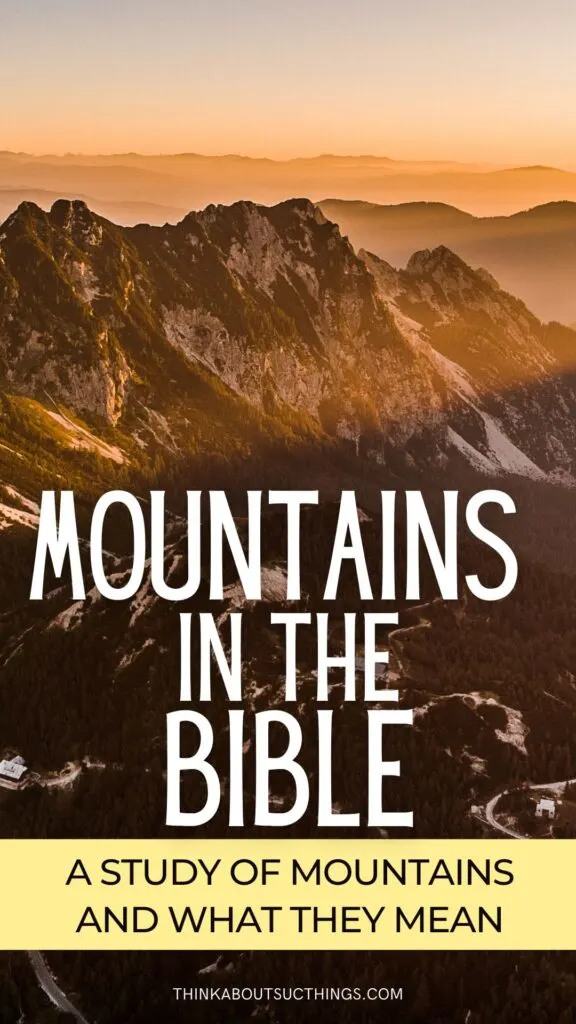
Table of Contents
Why Study the Mountains in the Bible?
As we delve into the study of the Mountains in the Bible, we come across many references to mountains. Here are a few reasons why studying the mountains in the Bible is essential:
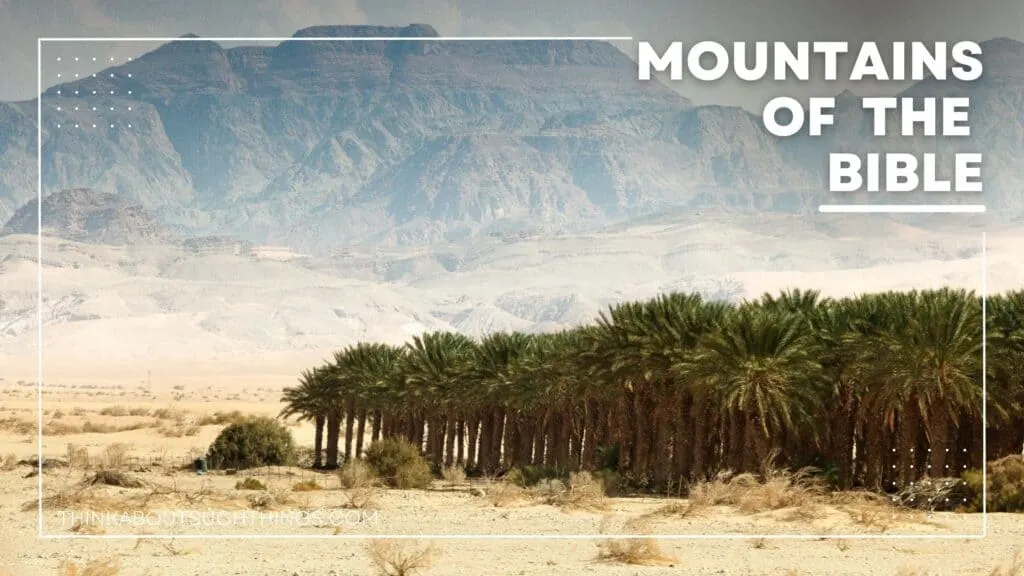
- Symbolism:
Mountains are often used as symbols of strength, stability, and permanence in the Bible. They represent the unchanging nature of God and His promises. By studying the mountains in the Bible, we can better understand the symbolism behind them and how they relate to our faith. - Geography:
Mountains played a significant role in the geography of the Bible. Many important events in the Bible took place on mountains, such as the giving of the Ten Commandments on Mount Sinai and the Sermon on the Mount. By studying, we can gain a deeper understanding of the geography of the lands where the events took place. - Metaphors:
Mountains are often used as metaphors for obstacles or challenges that we must overcome in our spiritual journey. By studying them, we can learn how to overcome these obstacles and challenges in our own lives.
These are just three big reasons to examine the mountains in the Bible. They can provide us with a deeper understanding of the scriptures and help us grow in our faith. It can also help us gain a greater appreciation for the beauty and majesty of God’s creation.
>>Check Out: 27 Powerful Bible Verses about Mountains
Mountains in the Old Testament
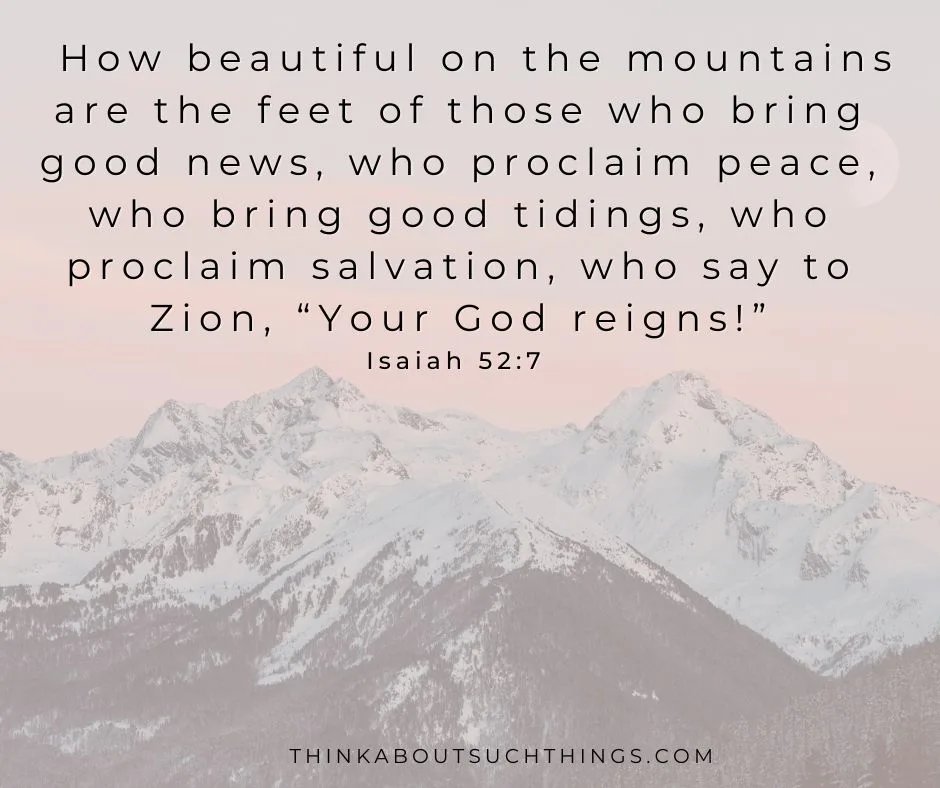
I thought breaking down the key mountains by the different testaments in the Bible would be easier for you to follow. I want to point out that many of these “mountains” in the Bible are not huge big ol’s mountains. Some are quite large and tall, but some are classified as large hills but still get the title of mount. This also rings true for mountains in the New Testament.
Mount Sinai
Mount Sinai is a mountain peak in the Sinai Peninsula of Egypt. According to the Old Testament, this is the mountain where Moses received the Ten Commandments from God. The story is told in the book of Exodus, where it is said that God descended upon the mountain in fire (shekinah glory), and Moses went up to receive the tablets of stone inscribed with the Ten Commandments.
From Smith’s Bible Dictionary:
“Names.—These mountains are called Horeb, and sometimes Sinai. Some think that Horeb is the name of the whole range, and Sinai the name of a particular mountain; others, that Sinai is the range and Horeb the particular mountain; while Stanley suggests that the distinction is one of usage, and that both names are applied to the same place.”Names.—These mountains are called Horeb, and sometimes Sinai. Some think that Horeb is the name of the whole range, and Sinai the name of a particular mountain; others, that Sinai is the range and Horeb the particular mountain; while Stanley suggests that the distinction is one of usage, and that both names are applied to the same place.”
Mount Moriah
Mount Moriah is the mountain where God commanded Abraham to sacrifice his son Isaac. According to the Bible, Abraham obeyed God’s command, but at the last moment, an angel stopped him from killing Isaac and provided a ram in Isaac’s place. It a beautiful and powerful story.
This event is considered a test of Abraham’s faith and obedience to God. Later, King Solomon built the Temple in Jerusalem on Mount Moriah.
Mount Zion
Mount Zion is a hill in Jerusalem that is mentioned several times in the Old Testament. It was the location of the Jebusite fortress that David conquered and made his capital.
Later, Solomon built the Temple on Mount Moriah, symbolizing God’s presence among his people. The term “Zion” came to represent the city of Jerusalem and the people of Israel.
Mount Ophel
Nestled between Mount Zion and Mount Moriah is Mount Ophel. It is mentioned 5 times in the Old Testament, with it’s first mention in 2 Chronicles 27:3.
From Easton’s Bible Dictionary:
“Ophel, (hill), a part of ancient Jerusalem. Ophel was the swelling declivity by which the mount of the temple slopes on its southern side into the valley of Hinnom—a long, narrowish rounded spur or promontory, which intervenes between the mouth of the central valley of Jerusalem (the Tyropoeon) and the Kidron, or valley of Jehoshaphat. Halfway down it on its eastern face is the (“Fount of the Virgin,” so called; and at its foot the lower outlet of the same spring—the Pool of Siloam.”
Mount Ararat
Mount Ararat is a volcanic mountain in eastern Turkey. According to the Bible, it is the place where Noah’s Ark landed after the Great Flood. The story is told in Genesis, where it is said that God instructed Noah to build an ark to save his family and the animals from the flood. After the waters receded, the ark came to rest on the mountains of Ararat.
From Easton’s Bible Dictionary:
“It has two conical peaks, about 7 miles apart, the one 14,300 feet and the other 10,300 feet above the level of the plain. Three thousand feet of the summit of the higher of these peaks is covered with perpetual snow. It is called Kuh-i-nuh, i.e., “Noah’s mountain”, by the Persians. This part of Armenia was inhabited by a people who spoke a language unlike any other now known, though it may have been related to the modern Georgian.”
Mount Carmel
Mount Carmel is a mountain range in northern Israel. It is mentioned several times in the Old Testament, including as the site of the showdown or should I say the beatdown between Elijah and the prophets of Baal.
In 1 Kings, Elijah challenged the prophets of Baal to a contest to see whose God would answer their prayers with fire. After the prophets of Baal failed, Elijah prayed to God, and fire came down from heaven and consumed his offering.
Mountains in the New Testament
And seeing the multitudes, He went up on a mountain, and when He was seated His disciples came to Him. – Matthew 5:1
The New Testament also mentions several mountains that play significant roles in the life and teachings of Jesus Christ. Let’s take a closer look at three of them:
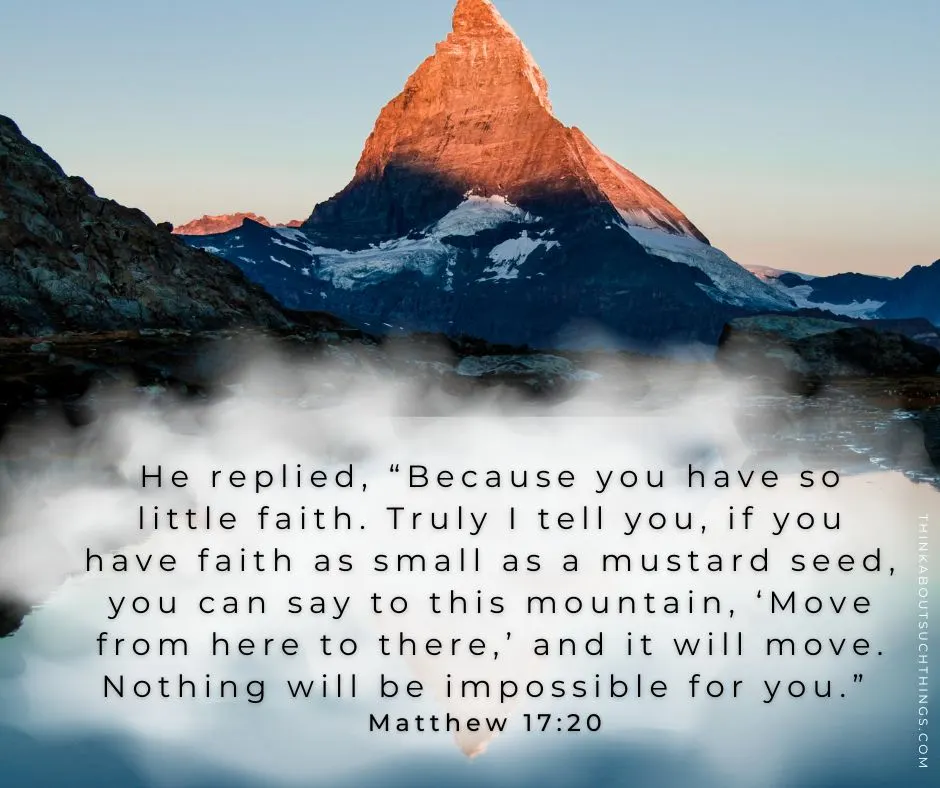
Mount of Olives
The Mount of Olives is located east of Jerusalem and is mentioned several times in the New Testament. It was a place where Jesus often went to pray and teach his disciples. One of the most significant events that took place on the Mount of Olives was Jesus’ ascension into heaven after his resurrection. It’s also the place where Jesus will return to!
I like how one person put it, “the mount of olives is the place of Jesus coming, going, & coming again“
Mount Tabor
Mount Tabor is located in the Lower Galilee region of Israel and is believed to be the site of the Transfiguration of Jesus. It is also the boundary line between several tribes: Issachar, Naphtali, and Zebulun.
Jesus took three of his disciples, Peter, James, and John, up to the top of Mount Tabor, where he was transfigured before them. His face shone like the sun, and His clothes became as white as light. Moses and Elijah also appeared to them, and a voice from heaven said, “This is my Son, whom I love; with him, I am well pleased. Listen to him!”
Mount Calvary or Golgotha
Mount Calvary, or Golgotha, would not be classified as a mountain but a knoll. But since it’s still a high place I thought it should be mentioned. It is believed to be located just outside the walls of Jerusalem. Jesus was led to Golgotha, where he was crucified along with two criminals. It is a place of great significance for Christians, as it represents the ultimate sacrifice that Jesus made for humanity.
From Easton’s Bible Dictionary:
“Golgotha: the common name of the spot where Jesus was crucified. It is interpreted by the evangelists as meaning “the place of a skull” (Matt. 27:33; Mark 15:22; John 19:17). This name represents in Greek letters the Aramaic word Gulgaltha, which is the Hebrew Gulgoleth (Num. 1:2; 1 Chr. 23:3, 24; 2 Kings 9:35), meaning “a skull.” It is identical with the word Calvary (q.v.). It was a little knoll rounded like a bare skull.”
These three mountains play significant roles in the life and teachings of Jesus Christ. They serve as reminders of the events that took place during his time on earth and continue to be places of pilgrimage and worship for Christians around the world.
The Symbolism of Mountains in the Bible
Mountains are a significant part of the Bible and are often used as symbols to convey various meanings. Let us explore some of the symbolism associated with mountains in the Bible:
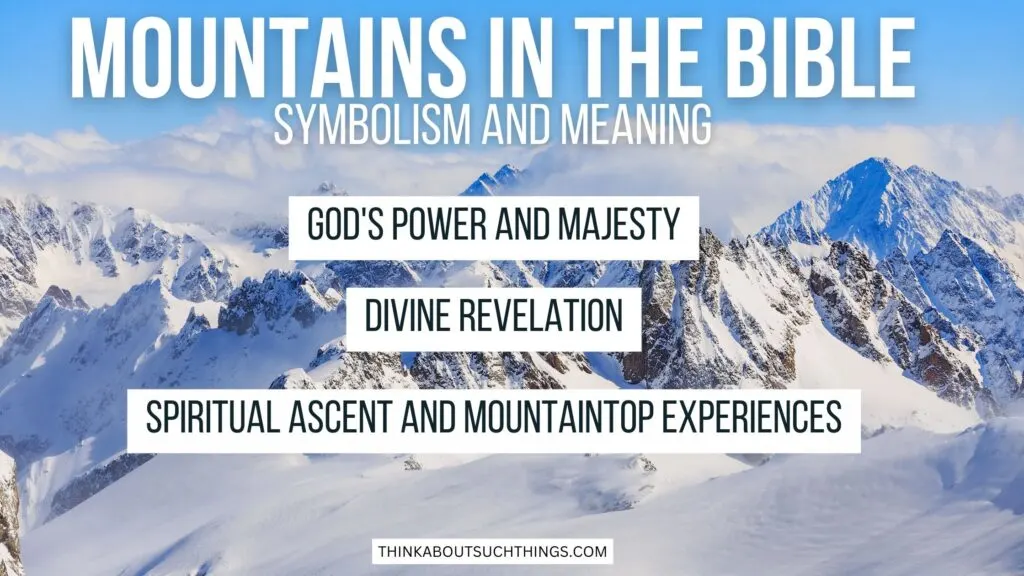
God’s Power and Majesty
Mountains are often used in the Bible to symbolize the power and majesty of God. The mountains are described as strong and unmovable, just like God.
For example, in Psalm 36:6, it says…
Your righteousness is like the great mountains;
Your judgments are a great deep;
O Lord, You preserve man and beast.
The mountains are a reminder of God’s righteousness, strength, and power!
This meaning of strength is also seen prophetically when we have visions and dreams. I remember a while back, I had a dream where I saw a huge mountain and this horrible storm was approaching it. I heard the Lord’s voice say, “Melissa be like that mountain that isn’t moved by the storm”.
What I didn’t realize was that God was preparing me for a season that would be very difficult but that He wanted me to be strong. He used a mountain symbolically to show me that.
Divine Revelation
Mountains are also used in the Bible to symbolize divine revelation. In the Bible, mountains are often the place where God reveals Himself to people. A prime example of this is when Moses went up to Mount Sinai.
And Moses went up to God, and the Lord called to him from the mountain, saying, “Thus you shall say to the house of Jacob, and tell the children of Israel: 4 ‘You have seen what I did to the Egyptians, and how I bore you on eagles’ wings and brought you to Myself. 5 Now therefore, if you will indeed obey My voice and keep My covenant, then you shall be a special treasure to Me above all people; for all the earth is Mine. 6 And you shall be to Me a kingdom of priests and a holy nation.’ These are the words which you shall speak to the children of Israel.” – Exodus 19:3-6,
The mountain is a symbol of the divine revelation that God provides to His people, and it is a reminder that God is always present and available to us.
Spiritual Ascent And Mountaintop Experiences
Mountains are also used in the Bible to symbolize spiritual ascent. Climbing a mountain requires effort and perseverance, just like our spiritual journey. In the Bible, climbing a mountain is a metaphor for drawing closer to God.
For example, in Psalm 24:3-4, it says,
Who may ascend into the hill of the Lord?
Or who may stand in His holy place?
4 He who has clean hands and a pure heart,
Who has not lifted up his soul to an idol,
Nor sworn deceitfully.
The experience of Moses and the burning bush on Mount Sinai is a great example of a mountaintop experience. Another amazing mountain experience was Jesus’ transfiguration.
On the flip side, mountain tops or high places were also used by pagan worship. I
You shall utterly destroy all the places where the nations which you shall dispossess served their gods, on the high mountains and on the hills and under every green tree. – Deuteronomy 12:2
I grew up in a city that is surrounded by beautiful mountains and trees. And many times when we would go visit these mountains, we would find new agers there channeling and trying to get “energy” from the mountain. This is basically the modern version of what we read in the Bible.
So, as we can see, the mountain symbolizes our spiritual ascent toward God or an encounter with Him.
I hope you have enjoyed this article on mountains in the Bible and that it has stored up your hunger to learn more about God’s Word!

Melissa is a passionate minister, speaker and an ongoing learner of the Bible. She has been involved in church and vocational ministry for over 18 years. And is the founder of Think About Such Things. She has the heart to equip the saints by helping them get into the Word of God and fall more in love with Jesus. She also enjoys family, cooking, and reading.
She has spoken in churches in California, Oregon, Texas, and Mexico and has been featured in Guidepost Magazine and All Recipes Magazine. Read More…
